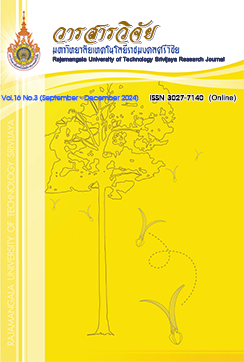Impact of Anti-stabbing Material Thickness from Ultra-high Molecular Weight Polyethylene Fabric on Penetration Depth
Keywords:
anti-stabbing material, ultra-high molecular weight polyethylene, hot compression moldingAbstract
The purpose of this research is to investigate the stab-resistant performance of ultra-high molecular weight polyethylene (UHMWPE) fabric molded into a sheet using a hot compression molding process with a thermoplastic resin, referred to as "UPE" in this study. The stab-resistant sheets were layered to the various specified thickness and tested for stab resistance performance using two types of blades: P1, a typical small knife, and S1, a commando-style blade or larger kitchen knife, following the National Institute of Justice (NIJ)-0115.00 standard. Mechanical properties characterizations revealed that the UPE sheet had maximum tensile and tear strengths of 162.50 MPa and 360.74 N/mm, respectively. The minimal thickness that could withstand stabs at E1 (Energy level 1) for both P1 and S1 type blades was 20 layers of UPE, or thickness of 4.8 mm. The E1 is the first energy level of the NIJ stab resistance testing, with an energy of 24 ± 0.50 J. Thus, it is appropriate for use as a stab-resistant material. When UPE was compared to other stab-resistant materials studied, it was discovered that the UPE had lower thickness and areal density than other materials at the same penetration depth. This indicates that the UPE was lighter and thinner than other materials. The light weight and thinness of UPE are significant factors in its development into stab-resistant armor.
References
Afshari, M., Sikkema, D.J., Lee, K. and Bogle, M. 2008. High performance fibers based on rigid and flexible polymers. In Polymer Reviews 48(2): 230-274.
Bogetti, T.A., Walter, M., Staniszewski, J. and Cline, J. 2017. Interlaminar shear characterization of ultra-high molecular weight polyethylene (UHMWPE) composite laminates. Composites Part A: Applied Science and Manufacturing 98: 105-115.
Chen, L., Cao, M. and Fang, Q. 2021. Ballistic performance of ultra-high molecular weight polyethylene laminate with different thickness. International Journal of Impact Engineering 156: 1-11.
Deák, T. and Czigány, T. 2009. Chemical Composition and Mechanical Properties of Basalt and Glass Fibers: A Comparison. Textile Research Journal 79(7): 645-651.
Guo, Y., Yuan, M., Qian, X., Wei, Y. and Liu, Y. 2020. Rapid prediction of polymer stab resistance performance. Materials and Design 192: 108721.
Huh, Y., Tien, D.T. and Kim, J.S. 2010. Stab-resistant property of the fabrics woven with the aramid/cotton core-spun yarns. Fibers and Polymers 11(3): 500-506.
Li, T., Song, Z., Yang, X. and Du, J. 2023. Influence of Processing Parameters on the Mechanical Properties of Peek Plates by Hot Compression Molding. Materials 16(1): 36.
Mejia, E., Cherupurakal, N., Mourad, A.H.I., Hassanieh, S.AI. and Rabia, M. 2021. Effect of processing techniques on the microstructure and mechanical performance of high-density polyethylene. Polymers 13(19): 3346.
Mudzi, P., Wu, R., Firouzi, D., Ching, C.Y., Farncombe, T.H. and Ravi Selvaganapathy, P. 2022. Use of patterned thermoplastic hot film to create flexible ballistic composite laminates from UHMWPE fabric. Materials and Design 214: 110403.
Nayak, R., Crouch, I., Kanesalingam, S., Wang, L., Ding, J., Tan, P., Lee, B., Miao, M., Ganga, D. and Padhye, R. 2018. Body armor for stab and spike protection, Part 2: a review of test methods. Textile Research Journal 89(16): 3411-3430.
O’Masta, M.R., Deshpande, V.S. and Wadley, H.N.G. 2014. Mechanisms of Projectile Penetration in Dyneema® Encapsulated Aluminum Structures. International Journal of Impact Engineering 74: 16-35.
Olszewska, K., Polak, J., Zielińska, D., Struszczyk, M.H., Kucińska, I., Wierzbicki, Ł., Kozłowska, J., Leonowicz, M. and Wiśniewski, A. 2013. Textile multilayered systems with magnetorheological fluids for potential application in multi-threat protections. Preliminary stab - Resistance studies. Fibres and Textiles in Eastern Europe 21(5): 112-116.
Pundhir, N., Pathak, H. and Zafar, S. 2021. Ballistic impact performance of ultra-high molecular weight polyethylene (UHMWPE) composite armour. Sādhanā 46: 194.
Sapozhnikov, S.B., Kudryavtsev, O.A. and Zhikharev, M.V. 2015. Fragment ballistic performance of homogenous and hybrid thermoplastic composites. International Journal of Impact Engineering 81: 8-16.
Shamloo, A., Fathi, B., Elkoun, S., Rodrigue, D. and Soldera, A. 2018. Impact of compression molding conditions on the thermal and mechanical properties of polyethylene. Journal of Applied Polymer Science 135(15): 46176.
Sitotaw, D.B., Ahrendt, D., Kyosev, Y. and Kabish, A.K. 2022. A Review on the Performance and Comfort of Stab Protection Armor. Autex Research Journal 22(1): 96-107.
Tien, D.T., Kim, J.S. and Huh, Y. 2011. Evaluation of anti-stabbing performance of fabric layers woven with various hybrid yarns under different fabric conditions. Fibers and Polymers 12(6): 808-815.
Yashiro, S., Ogi, K., Yoshimura, A. and Sakaida, Y. 2014. Characterization of high-velocity impact damage in CFRP laminates: Part II - Prediction by smoothed particle hydrodynamics. Composites Part A: Applied Science and Manufacturing 56: 308-318.
Yuan, M.Q., Liu, Y., Gong, Z. and Qian, X.M. 2017. The application of PA/CF in stab resistance body armor. IOP Conference Series: Materials Science and Engineering 213(1): 12027.
Zaribaf, F.P. 2018. Medical-grade ultra-high molecular weight polyethylene: past, current and future. In Materials Science and Technology (United Kingdom) 34(16): 1940-1953.
Downloads
Published
How to Cite
Issue
Section
License
Copyright (c) 2024 Rajamangala University of Technology Srivijaya Research Journal

This work is licensed under a Creative Commons Attribution-NonCommercial-NoDerivatives 4.0 International License.
The content and information in the article published in Journal of Rajamangala University of Technology Srivijaya It is the opinion and responsibility of the author of the article. The editorial journals do not need to agree. Or share any responsibility.







